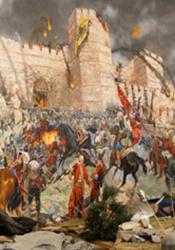The Fall of Constantinople
The fall of Constantinople marked the end of the Byzantine Empire after ten centuries of war. The Ottoman Turks defeated felled the city and ended the European Middle Ages.
The Byzantine Empire had been a bastion of Christian Europe facing Muslim Asia. The Ottoman Turks were expanding their empire and saw Constantinople as a center of the rival Christian faith and a symbol of imperial power.
Constantinople had held off many attempts to destroy or capture it but was declining in power over the years. Mehmed II set out to take the city in the spring of 1453 and used the sea to gain access to the city. Initial attacks failed, but on May 29th, Mehmed launched attacks from the sea and the land simultaneously. The Ottomans were finally able to overwhelm the defenses due to the use of gunpowder-powered cannons. After gaining access past the walls, the Ottomans killed the emperor and massacred the citizens.
Mehmed rode a white horse down streets that ran with blood to Hagia Sophia, the city's famed cathedral. He used the cathedral as a mosque to say prayers of thanks for the victory.
The fall of Constantinople was important because it was a watershed moment in military history. The city had defended itself with walls and ramparts since ancient times. These fortifications were used as the model of many later cities. The end of the Byzantine Empire marks the end of the Medieval period.
Bunting, Tony. “Fall of Constantinople.” Encyclopædia Britannica, Encyclopædia Britannica, Inc., 22 May 2018, www.britannica.com/event/Fall-of-Constantinople-1453.
“Fall of Constantinople.” Wikipedia, Wikimedia Foundation, 2 May 2019, en.wikipedia.org/wiki/Fall_of_Constantinople.

